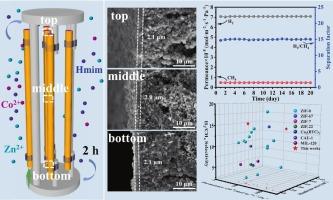Scalable synthesis of bimetallic ZIF membranes on the inner-surface of ZnO hollow fiber for gas separation
IF 9
1区 工程技术
Q1 ENGINEERING, CHEMICAL
引用次数: 0
Abstract
Metal-organic framework (MOF) membranes with high stability and porosity have shown great potential for efficient hydrogen separation. As a result, searching for a simple and efficient synthesis method to synthesize large-area, continuous, and dense MOF membrane has received an extensive attention. In this work, we demonstrated that a support-induced synthesis strategy to fabricate a series of 20-cm long bimetallic Zn/Co-ZIF membranes on the inner surface of ZnO hollow fiber. Uniform-thickness Zn/Co-ZIF membranes were prepared by periodically inverting the autoclave to alter the flow state of the synthesis solution inside the hollow fibers. The obtained Zn/Co-ZIF membrane showed a good H2/CH4 selectivity of 15.75 with a H2 permeance of 1.15 × 10−7 mol·m−2·s−1·Pa−1 and the membrane displayed excellent long-term operation stability for 20 days. Furthermore, the 11 Zn/Co-ZIF membranes (with a membrane area up to about 100.91 cm2) were successfully prepared in an autoclave in order to further improve the metal source utility. These membranes exhibited similar H2 separation performance, with H2/CH4 selectivities of 12.69–14.59 and H2 permeances of 1.64–2.05 × 10−7 mol·m−2·s−1·Pa−1, demonstrating excellent reproducibility.

气体分离用ZnO中空纤维内表面可扩展合成双金属ZIF膜
金属有机骨架(MOF)膜具有较高的稳定性和孔隙率,在高效氢分离方面具有很大的潜力。因此,寻找一种简单高效的合成方法来合成大面积、连续、致密的MOF膜受到了广泛的关注。在这项工作中,我们展示了一种支持诱导合成策略,在ZnO中空纤维的内表面制备了一系列20厘米长的双金属Zn/Co-ZIF膜。通过周期性翻转高压灭菌器,改变合成溶液在中空纤维内的流动状态,制备了均匀厚度的Zn/Co-ZIF膜。所得的Zn/Co-ZIF膜H2/CH4选择性为15.75,H2透过率为1.15 × 10−7 mol·m−2·s−1·Pa−1,长期运行稳定性为20 d。此外,为了进一步提高金属源的实用性,在高压灭菌器中成功制备了11个Zn/Co-ZIF膜(膜面积高达约100.91 cm2)。这些膜具有相似的H2分离性能,H2/CH4选择性为12.69 ~ 14.59,H2渗透率为1.64 ~ 2.05 × 10−7 mol·m−2·s−1·Pa−1,具有良好的重复性。
本文章由计算机程序翻译,如有差异,请以英文原文为准。
求助全文
约1分钟内获得全文
求助全文
来源期刊

Separation and Purification Technology
工程技术-工程:化工
CiteScore
14.00
自引率
12.80%
发文量
2347
审稿时长
43 days
期刊介绍:
Separation and Purification Technology is a premier journal committed to sharing innovative methods for separation and purification in chemical and environmental engineering, encompassing both homogeneous solutions and heterogeneous mixtures. Our scope includes the separation and/or purification of liquids, vapors, and gases, as well as carbon capture and separation techniques. However, it's important to note that methods solely intended for analytical purposes are not within the scope of the journal. Additionally, disciplines such as soil science, polymer science, and metallurgy fall outside the purview of Separation and Purification Technology. Join us in advancing the field of separation and purification methods for sustainable solutions in chemical and environmental engineering.
 求助内容:
求助内容: 应助结果提醒方式:
应助结果提醒方式:


